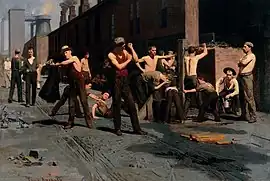| The Ironworkers' Noontime | |
|---|---|
 | |
| Artist | Thomas Anshutz |
| Year | 1880 |
| Medium | Oil on canvas |
| Dimensions | 43.2 cm × 60.6 cm (17.0 in × 23.9 in) |
| Location | Fine Arts Museums of San Francisco |
The Ironworker's Noontime is an 1880 painting by the American painter Thomas Anshutz.
The painting depicts several workers on their break in the yard of a foundry and is one of the most popular of Anshutz' paintings. Painted near Wheeling, West Virginia, it is conceived in a naturalistic style featuring realistic anatomical depictions of men and boys similar to that of Thomas Eakins, although Eakins never painted industrial subjects.[1] Also like Eakins, Anshutz composed this painting with the help of photographs and studies. Some of the figures are depicted in a classical pose, such as the man in the foreground rubbing his arm. This figure's pose imitates a pose from the Parthenon.[2] The piece was exhibited at the Philadelphia Sketch Club in 1881 and compared to Eakin's work by art critics. Art historian Randall C. Griffin has written of it: "One of the first American paintings to depict the bleakness of factory life, The Ironworkers' Noontime appears to be a clear indictment of industrialization. Its brutal candor startled critics, who saw it as unexpectedly confrontational—a chilling industrial snapshot not the least picturesque or sublime."[3] It is now in the collection of the Fine Arts Museums of San Francisco.[4]
References
- ↑ Griffin, 2004, p. 59.
- ↑ Vigue, Jordi (2004). Great Masters of American Art. New York: Watson-Guptill Publications. pp. 338. ISBN 0823021157.
- ↑ Griffin, 2004, p. 61.
- ↑ "The Ironworkers' Noontime, 1880". Cosmopolitan and Candid Stories, 1877–1915. Metropolitan Museum of Art. 2011. Retrieved 11 Jul 2011.
Bibliography
- Griffin, Randall C. (2004). Homer, Eakins, & Anshutz: The Search for American Identity in the Gilded Age. University Park: Pennsylvania State University Press. ISBN 0-271-02329-5